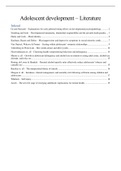Samenvatting
Complete samenvatting van alle artikelen voor de cursus Adolescent Development
- Vak
- Instelling
Ge and Natsuaki – Explanations for early pubertal timing effects on developmental psychopathology Steinberg and Scott – Developmental immaturity, diminished responsibility and the juvenile death penalty Hardy and Carlo – Moral identity Kaufman, Baams and Dubas – Microaggressions an...
[Meer zien]




